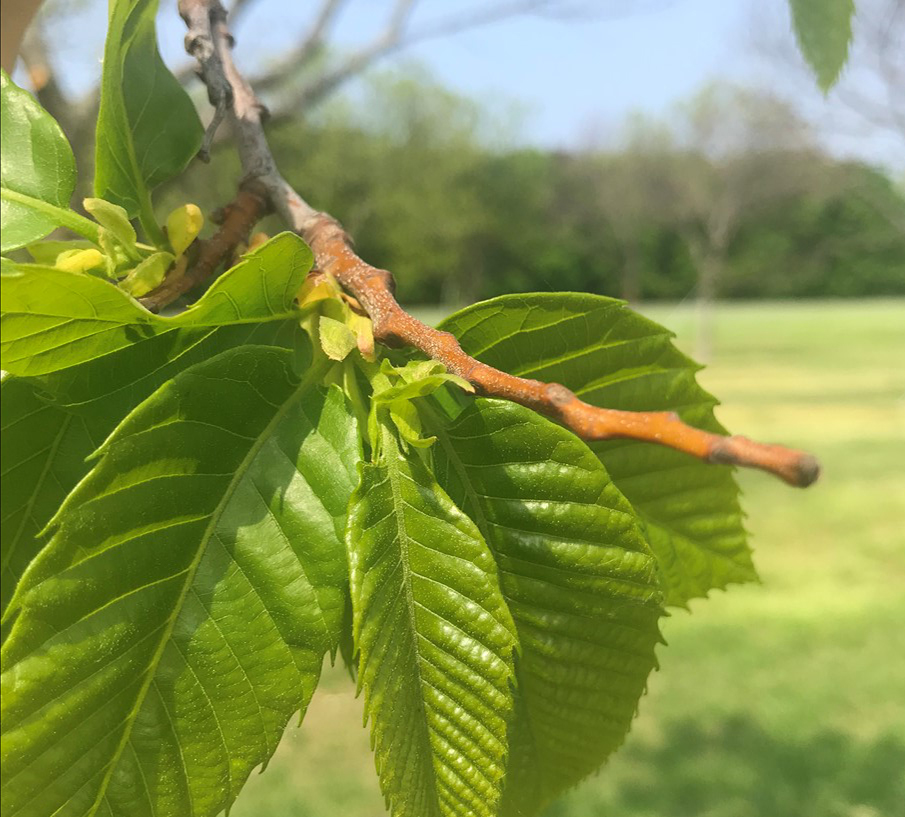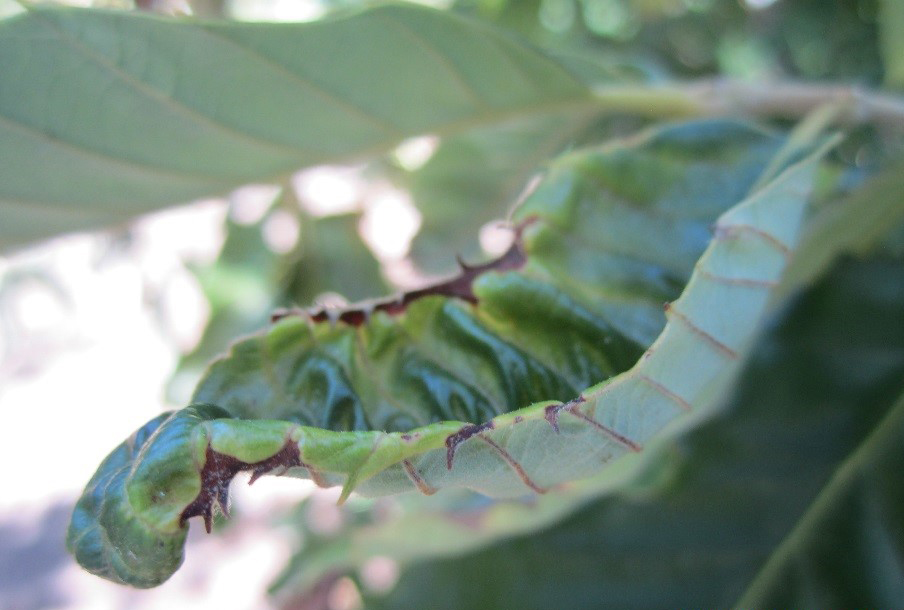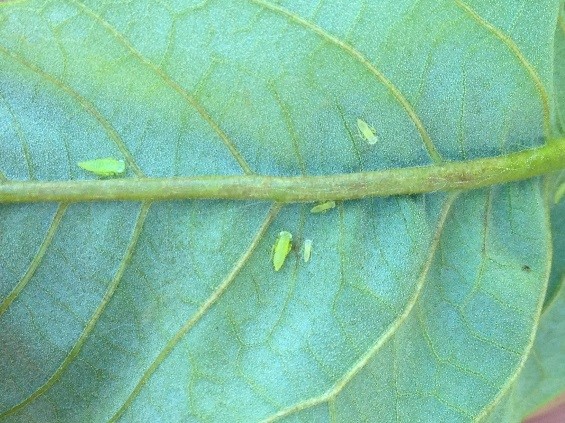Michigan chestnut scouting report – July 25, 2019
Potato leafhopper populations are high around Michigan and growers continue reporting trees failing from winter damage.

Despite the hot weather over the last couple of weeks, Michigan is still behind in degree day accumulation compared to the five-year average. Growers continue to report high levels of winter injury to both young and established trees.
Winter injury
Harsh winter conditions in January likely caused much of the injury we are now seeing in a number of perennial cropping systems in Michigan. A decrease in cold hardiness is one way trees can be injured during dormancy. Trees from regions of the world that experience cold temperatures have adapted to withstand varying levels of cold, expressed as cold hardiness. Cold hardiness levels increase as temperatures decline in the fall and builds over time to a maximum level mid-winter. Hardiness then decreases as temperatures slowly warm in late winter. Warm periods during the winter reduce a tree’s cold hardiness and cause winter injury when temperatures drop again. Freezing injury may occur during these temperature fluctuations, potentially causing tree death. Damage from intense sunlight on the southern side of the tree can also cause local damage from a loss of cold hardiness, commonly referred to as “southwest disease.”
Winter injury during tree dormancy can also occur from low humidity, sunny conditions and high winds that desiccate bud and twig tissue causing dehydration, damage and death. Affected tissues turn brownish red or black and take on a shrunken, wrinkled appearance. Injured twigs become brittle and the growth cambium located just below the bark is brown. Injured buds can dry out or simply fail to swell and develop.

Cold damage can also occur as succulent new shoots and leaves begin to emerge at bud break. Cultivars that break bud early are exposed to spring temperature fluctuations for a longer period of time, making them more vulnerable to spring cold snaps and more frequent injury. As the tree breaks dormancy and sap begins to flow, leaves and shoots begin to expand as the tree rehydrates. At this time, the tree has lost any cold hardiness gained over winter. If temperatures drop significantly below freezing for a short period or stay at or just below freezing for an extended period, then frost and freeze injury can occur. High winds and temperature inversions can exacerbate this type of cold injury. Cold injury to new shoots can lead to undesirable tree structure over time and limit bur production.
The most recent Farm Bill authorized the Tree Assistance Program to provide financial assistance to orchardists and nursery tree growers to replant or rehabilitate eligible trees, bushes and vines damaged by natural disasters, including chestnuts. The Tree Assistance Program is administered by the Farm Service Agency (FSA), a division of the U.S. Department of Agriculture.
According to the Tree Assistance Program fact sheet, eligible trees, bushes and vines are those from which an annual crop is produced for commercial purposes. Nursery trees include ornamental, fruit, nut and Christmas trees produced for commercial sale. Trees used for pulp or timber are ineligible. To be considered an eligible loss:
- The plants must have been lost or damaged as a result of natural disaster.
- The stand must have sustained a mortality loss or damage loss in excess of 15%, not including normal mortality or damage.
- The loss could not have been prevented through reasonable and available measures.
- Damage or loss must be visible and obvious. If the damage is no longer visible, FSA may accept other loss evidence that the agency determines is reasonable.
If you have eligible tree, shrub or vine losses or expect you might, contact your local FSA office to report it now so it is documented. Reports must be filed within three months of observing the damage.
Potato leafhopper

Potato leafhopper populations are quite high this year and have represented the greatest pest challenge to growers. Like many plants, chestnuts are sensitive to the saliva of potato leafhopper, which is injected by the insect while feeding. Damage to leaf tissue can cause reduced photosynthesis, which can impact production, quality, and damage the tree.
Most injury occurs on new tissue on shoot terminals with potato leafhopper feeding near the edges of the leaves using piercing-sucking mouthparts. Symptoms of feeding appear as whitish dots arranged in triangular shapes near the edges. Heavily damaged leaves are cupped with necrotic and chlorotic edges and eventually abscise from the tree. Severely infested shoots produce small, bunched leaves with reduced photosynthetic capacity.
Adult leafhoppers are pale to bright green and about 0.125 inch long. Adults are easily noticeable, jumping, flying or running when agitated. The nymphs (immature leafhoppers) are pale green and have no wings but are very similar in form to the adults. The potato leafhopper can’t survive Michigan’s winter and survives in the Gulf States until adults migrate north in the spring on storm systems.

Scout weekly as soon as leaf tissue is present to ensure detection early and prevent injury. Spot-check frequently following rain storms, which carry the first populations north. For every acre of orchard, select five trees to examine and inspect the leaves on three shoots per tree (a total of 15 shoots per acre). The easiest way to observe potato leafhopper is by flipping the shoots or leaves over and looking for adults and nymphs on the underside of leaves. Pay special attention to succulent new leaves on the terminals of branches.
For more information on insecticides available for the treatment of potato leafhopper, refer to the current “Chestnut Management Guide” from Michigan State University Extension.
Crop estimate
As burs begin to form over the coming month, growers will begin to estimate crop load. For more information on estimating crop load, refer to the MSU Extension article, “Estimating crop load in edible chestnuts.”
Stay in touch!
Want to receive more pest management information for chestnut this season? Sign up to receive the MSU Extension Fruit & Nuts Newsletter or follow us on Facebook.
Important dates
- Sept. 7, 2019, Midwest Chestnut Producers Council Farm Tour at Nash Nurseries in Owosso, Michigan.
This work is supported by Project GREEEN and the Crop Protection and Pest Management Program 2017-70006-27175 from the USDA National Institute of Food and Agriculture. Any opinions, findings, conclusions or recommendations expressed in this publication are those of the author(s) and do not necessarily reflect the view of the U.S. Department of Agriculture.
This work is also supported by the Rogers Reserve Endowment.



 Print
Print Email
Email




